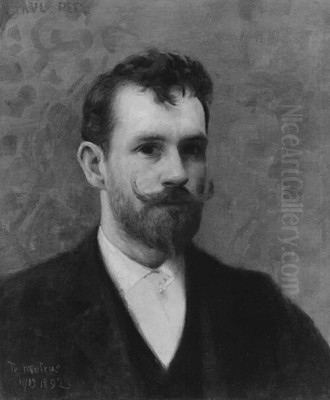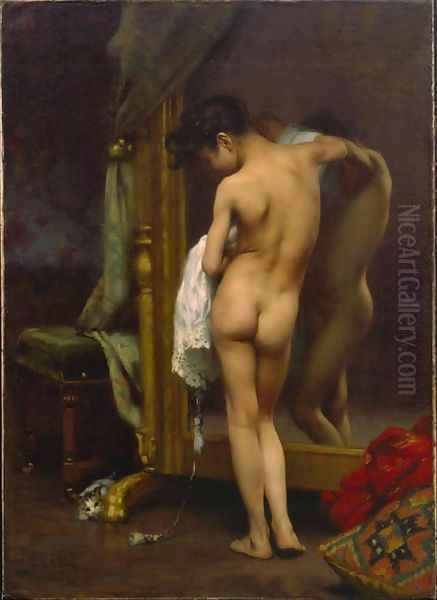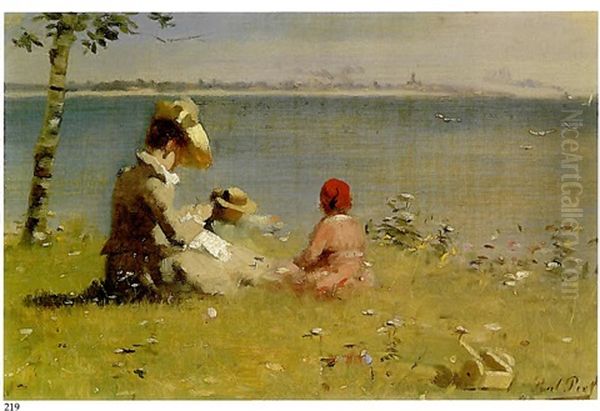
Paul Peel stands as a significant, albeit tragically short-lived, figure in the annals of Canadian art history. A product of the late 19th century, an era of burgeoning national identity and increasing international artistic exchange, Peel navigated the traditional academic training systems of his time while simultaneously absorbing the nascent currents of Impressionism. His legacy is primarily built upon his tender and often sentimental depictions of children, as well as his pioneering exploration of the nude figure within a Canadian context. Though his career was brief, his achievements, particularly his success at the prestigious Paris Salon, marked a notable moment for Canadian artists seeking recognition on the global stage.
Early Life and Artistic Awakenings in Ontario
Born on November 7, 1860, in London, Ontario, Paul Peel's artistic inclinations were nurtured from a young age. His father, John Robert Peel, was a multifaceted craftsman – a marble cutter by trade but also a drawing instructor. This familial environment undoubtedly provided Paul with his initial exposure to artistic practice and discipline. The elder Peel's own artistic pursuits, though perhaps more modest, created a supportive atmosphere for his son's burgeoning talent.
Before venturing abroad, Paul Peel received foundational art training in his hometown. He studied under William Lees Judson, a British-born artist who had established himself in London, Ontario. Judson, who would later move to California and become Dean of the University of Southern California's College of Fine Arts, provided Peel with early formal instruction. This initial tutelage in Canada laid the groundwork for the more rigorous academic training Peel would later seek in the United States and Europe.
Formative Years: Philadelphia and the Pennsylvania Academy of the Fine Arts
Recognizing the need for more advanced instruction, Peel, around 1877, made the pivotal decision to move to Philadelphia to enroll at the Pennsylvania Academy of the Fine Arts (PAFA). At the time, PAFA was one of the leading art institutions in North America, renowned for its rigorous curriculum rooted in the European academic tradition. Here, Peel came under the tutelage of influential figures such as the Danish-born history painter Christian Schüssele and, most notably, Thomas Eakins.

Eakins, a towering figure in American realism, was known for his uncompromising commitment to anatomical accuracy and direct observation. His emphasis on studying from live models and dissecting cadavers profoundly impacted his students, instilling in them a respect for empirical study. While Peel's later work would not fully embrace Eakins' stark realism, the discipline and observational skills honed at PAFA were undoubtedly crucial to his development. During his three years in Philadelphia, Peel absorbed the tenets of academic draftsmanship and composition, skills that would serve him well in his subsequent European studies. He also reconnected with William Lees Judson, who was also studying at PAFA, and the two often sketched together.
The London Interlude: Royal Academy Schools
Following his studies in Philadelphia, around 1880, Peel crossed the Atlantic, initially heading to London, England. He briefly attended the Royal Academy Schools. This institution, much like PAFA, was steeped in academic tradition, emphasizing classical ideals and meticulous technique. While his time in London was relatively short, it provided another layer to his academic grounding and exposed him to the British art scene, which, while conservative compared to Paris, had its own distinct character, with artists like Frederic Leighton and Lawrence Alma-Tadema upholding the classical tradition.
This period served as a stepping stone, further refining his skills before he moved to what was then considered the undisputed capital of the art world: Paris. The allure of Paris, with its vibrant artistic community, numerous ateliers, and the all-important Salon, was irresistible for ambitious young artists from around the globe.
The Parisian Crucible: École des Beaux-Arts and Esteemed Mentors
Upon arriving in Paris, likely in the early 1880s, Paul Peel immersed himself in the city's rich artistic environment. He gained admission to the prestigious École des Beaux-Arts, the epicenter of academic art training in France. Here, he studied under some of the most renowned academic painters of the era. Among his principal instructors was Jean-Léon Gérôme, a master of historical and Orientalist painting, celebrated for his polished technique and meticulous detail. Gérôme's studio was a magnet for international students, and his influence in upholding academic standards was immense.
Peel also benefited from the guidance of other prominent academicians, including Jules Joseph Lefebvre, known for his elegant nudes and portraits, and Gustave Boulanger, another respected figure in the academic tradition, often collaborating with Gérôme. He also studied with Henri Doucet and the highly successful portraitist and Orientalist painter Benjamin Constant. These masters instilled in Peel a profound respect for draftsmanship, composition, and the idealized human form, hallmarks of the academic style. The training was intense, focusing on drawing from plaster casts, then from live models, and eventually progressing to complex multi-figure compositions.
Artistic Style: A Synthesis of Academicism and Impressionistic Sensibilities

Paul Peel's artistic style is best characterized as a blend of French academic tradition and the burgeoning influence of Impressionism. His rigorous training under Gérôme and Lefebvre is evident in the solid draftsmanship, smooth finish, and carefully constructed compositions found in many of his works. He possessed a keen ability to render human anatomy with accuracy and grace, a skill honed through years of academic study.
However, Peel was not immune to the revolutionary changes occurring in the Parisian art world. While not a core member of the Impressionist group, which included artists like Claude Monet, Edgar Degas, and Pierre-Auguste Renoir, Peel adopted certain aspects of their approach. This is most apparent in his treatment of light and color, and his choice of subject matter. He often depicted intimate, everyday scenes, particularly focusing on the world of children. His palette, while not as broken or vibrant as the high Impressionists, often showed a greater sensitivity to the effects of light and atmosphere than was typical of purely academic painters. Works like Autumn Leaves showcase this delicate handling of light and a sentimental, yet observational, approach to his subjects.
His paintings of children are characterized by a tender sympathy, capturing their innocence and unselfconscious gestures. He also became one of the first Canadian artists to extensively explore the nude, a subject central to academic training but often treated with caution in the more conservative social climate of Canada. His nudes, typically female figures or children, are rendered with a sensuousness that is tempered by an academic concern for form and idealization.
The Pinnacle of Success: After the Bath and the Paris Salon
The culmination of Peel's Parisian training and artistic development arrived in 1890 with his painting After the Bath (also known as Le Bain or Après le Bain). This charming and technically accomplished work depicts two young children, likely his own son Robert and daughter Marguerite, warming themselves before a fireplace after their bath. The painting masterfully captures the soft glow of the firelight on their skin, the innocent interaction between the siblings, and the cozy domestic atmosphere.

Exhibited at the prestigious Paris Salon of 1890, After the Bath was a resounding success. It was awarded a gold medal (some sources say bronze, but gold is more widely cited in relation to its subsequent purchase), a significant honor for any artist, let alone a Canadian working abroad. This accolade brought Peel international recognition. The painting was subsequently purchased by the Hungarian government for the National Gallery in Budapest for the sum of 8,000 francs, despite reported higher offers from private collectors. This official acquisition further solidified Peel's reputation and was a moment of immense pride for the Canadian artistic community. The work became, and remains, his most iconic painting, celebrated for its technical skill, sentimental appeal, and the successful fusion of academic polish with a more modern sensibility in its treatment of light and subject.
Other Notable Works and Thematic Concerns
While After the Bath is his most famous piece, Paul Peel produced a considerable body of work during his relatively short career. His oeuvre consistently reflects his interest in genre scenes, particularly those involving children, and his adeptness at figure painting.
A Venetian Bather (1889) is another significant work, showcasing his skill in depicting the female nude in an outdoor setting, with a careful modulation of light on flesh. The painting demonstrates his academic training in rendering form, combined with a softer, more atmospheric quality that hints at Impressionist influences.
The Tired Model (1889) offers a glimpse into the artist's studio life, a common theme among academic painters. It portrays a young model resting, capturing a moment of informal repose, yet still rendered with the careful attention to anatomy and form expected from a Salon painter.
Boy and Dog (circa 1880s-1890) is another example of his popular child-themed paintings, exuding warmth and a sentimental charm that appealed to contemporary audiences. These works often featured his own children as models, lending an intimate and personal quality to the depictions.
Paintings like Rest and Good News, Toronto further illustrate his engagement with everyday life and narrative genre scenes. While these works were generally well-received for their technical proficiency and accessible subject matter, some critics then and now have noted that his color palette could sometimes appear somewhat restrained or "pale" when compared to the more radical color experiments of the Impressionists like Renoir or Degas. Nevertheless, his ability to capture tender moments and his skillful handling of light and form were widely acknowledged.
Life in Paris and Pont-Aven: Connections and Influences
During his time in Paris, Paul Peel was part of a vibrant expatriate artistic community. He formed a close friendship with fellow Canadian artist George Agnew Reid. Their relationship was one of mutual support and friendly rivalry, as both artists were striving for recognition at the Paris Salon. Reid's memoirs recall them preparing their Salon submissions together, even ordering frames from the same craftsman. This camaraderie was typical of artists living abroad, sharing experiences and ambitions far from home.

Peel also maintained his connection with William Lees Judson, who had also made his way to Paris. Their shared North American roots and artistic aspirations likely fostered a continued bond. Beyond his Canadian compatriots, Peel's interactions would have extended to the broader circle of students and artists frequenting the ateliers and cafes of Montparnasse and the Latin Quarter.
Significantly, Peel also spent time painting in Pont-Aven, Brittany. This picturesque village had become a popular artists' colony, attracting painters drawn by its rustic charm, distinct local culture, and affordable living. By the late 1880s, Pont-Aven was famously associated with Paul Gauguin and Émile Bernard, who were developing the Synthetist style there. While Peel's work does not show a direct stylistic alignment with the avant-garde experiments of Gauguin's circle, his presence in Pont-Aven indicates his engagement with plein-air painting and the broader artistic currents of the time. The experience of painting outdoors in Brittany likely further encouraged his sensitivity to light and atmosphere. Other artists associated with Pont-Aven around this period included Paul Sérusier and Louis Anquetin, contributing to a dynamic artistic milieu.
A Bittersweet Return and Challenges in Canada
The triumph of After the Bath at the 1890 Paris Salon marked the zenith of Paul Peel's career. Following this success, he made a return visit to Canada. However, this period was tinged with personal sorrow, as his mother fell seriously ill. This family crisis necessitated his presence and undoubtedly placed emotional strain on him during what should have been a period of unadulterated celebration of his international acclaim.
Professionally, Peel also encountered the challenges faced by many Canadian artists of his generation when trying to establish a market for their work back home. Despite his international success, exhibitions of his paintings in Toronto and Montreal reportedly met with a lukewarm commercial response. An auction of his works yielded disappointing results, with only a few pieces selling. This reflected a broader issue in Canada at the time: a relatively conservative art market and a preference among some collectors for European, rather than domestic, art. The themes Peel explored, particularly the nude, while accepted in Paris, may have also faced a more reserved reception in parts of Canadian society.
He was an active member of Canadian art organizations, including the Ontario Society of Artists (OSA) and the Royal Canadian Academy of Arts (RCA), becoming a full member of the RCA in 1890 (some sources state 1882 as an associate, with full membership later). He exhibited regularly with these bodies, contributing to the growing Canadian art scene.
Anecdotes and Artistic Standing
One anecdote that has surfaced involves an artist named "Hunt" (the specific identity is not always clear, and it's unlikely to be the famous Pre-Raphaelite William Holman Hunt given the context) who was commissioned to copy one of Peel's paintings, a portrait of a child's head. When the client wished to see the original, Hunt allegedly obscured Peel's signature, perhaps indicative of the competitive, and sometimes ethically ambiguous, nature of the art world.
Another point of discussion, or mild controversy, surrounding Peel's work, particularly After the Bath, was its very sentimentality. While popular with the public, some critics found such themes overly sweet or sentimental, a common critique leveled against certain Victorian and academic painters. However, the technical skill displayed in such works was rarely disputed. His father, John R. Peel, also an artist, exhibited alongside Paul in London in 1883, an event that reportedly caused some professional jealousy within art circles, perhaps due to the father's role in organizing the exhibition.
Premature End and Lasting Legacy
Tragically, Paul Peel's promising career was cut short. He died prematurely on October 3, 1892, in Paris, at the young age of 31 (not 1922 as some early erroneous records suggested). The cause of his death was a lung infection, possibly exacerbated by the demanding and often poorly heated conditions of 19th-century artists' studios. His early demise was a significant loss to Canadian art, leaving unfulfilled the potential of a painter who had already achieved remarkable international success.
Despite the limited commercial success in Canada during his lifetime, Peel's reputation grew posthumously. His Salon triumph remained a benchmark for Canadian artists. Over time, and particularly with a resurgence of interest in 19th-century academic and figurative art in the later 20th century (notably from the 1970s onwards), Peel's work has been re-evaluated and appreciated for its technical finesse and its role in Canadian art history. His paintings are now held in major Canadian collections, including the National Gallery of Canada and the Art Gallery of Ontario. Retrospectives, such as the one held at the London Regional Art Gallery (now Museum London) in 1986-87, have helped to solidify his place.
Paul Peel is remembered as a pioneer, one of the first Canadian-born artists to achieve significant recognition in the competitive Parisian art world. He successfully navigated the academic system while subtly incorporating more modern, Impressionistic sensibilities into his work. His depictions of childhood innocence and his sensitive rendering of the human form continue to resonate, securing his position as an important figure in the development of Canadian art. His contemporaries included other Canadian artists striving for recognition, such as Lucius O'Brien, Homer Watson, and later, figures like James Wilson Morrice, who would also find success in Paris.
Conclusion: An Enduring Canadian Talent
Paul Peel's life and career, though brief, offer a compelling narrative of artistic ambition, transatlantic study, and international achievement. From his early training in Ontario to his academic immersion in Philadelphia and Paris under masters like Thomas Eakins and Jean-Léon Gérôme, Peel meticulously honed his craft. His ability to synthesize the rigorous demands of academic painting with a softer, more intimate and light-filled approach, particularly evident in his celebrated depictions of children like After the Bath, earned him accolades at the highest levels of the art world.
While he faced challenges in gaining widespread patronage in his homeland during his lifetime, his success abroad, especially at the Paris Salon, served as an inspiration and a testament to Canadian talent on the world stage. Today, Paul Peel is rightfully recognized for his skillful artistry, his pioneering role in broadening thematic concerns within Canadian art, and his enduring contribution to the nation's cultural heritage. His works remain a poignant reminder of a gifted artist whose full potential was tragically curtailed but whose legacy endures.